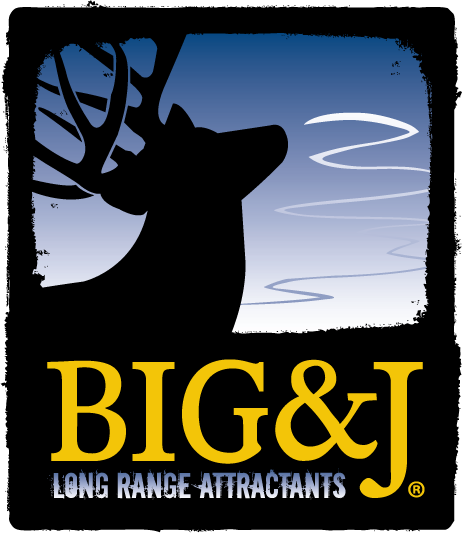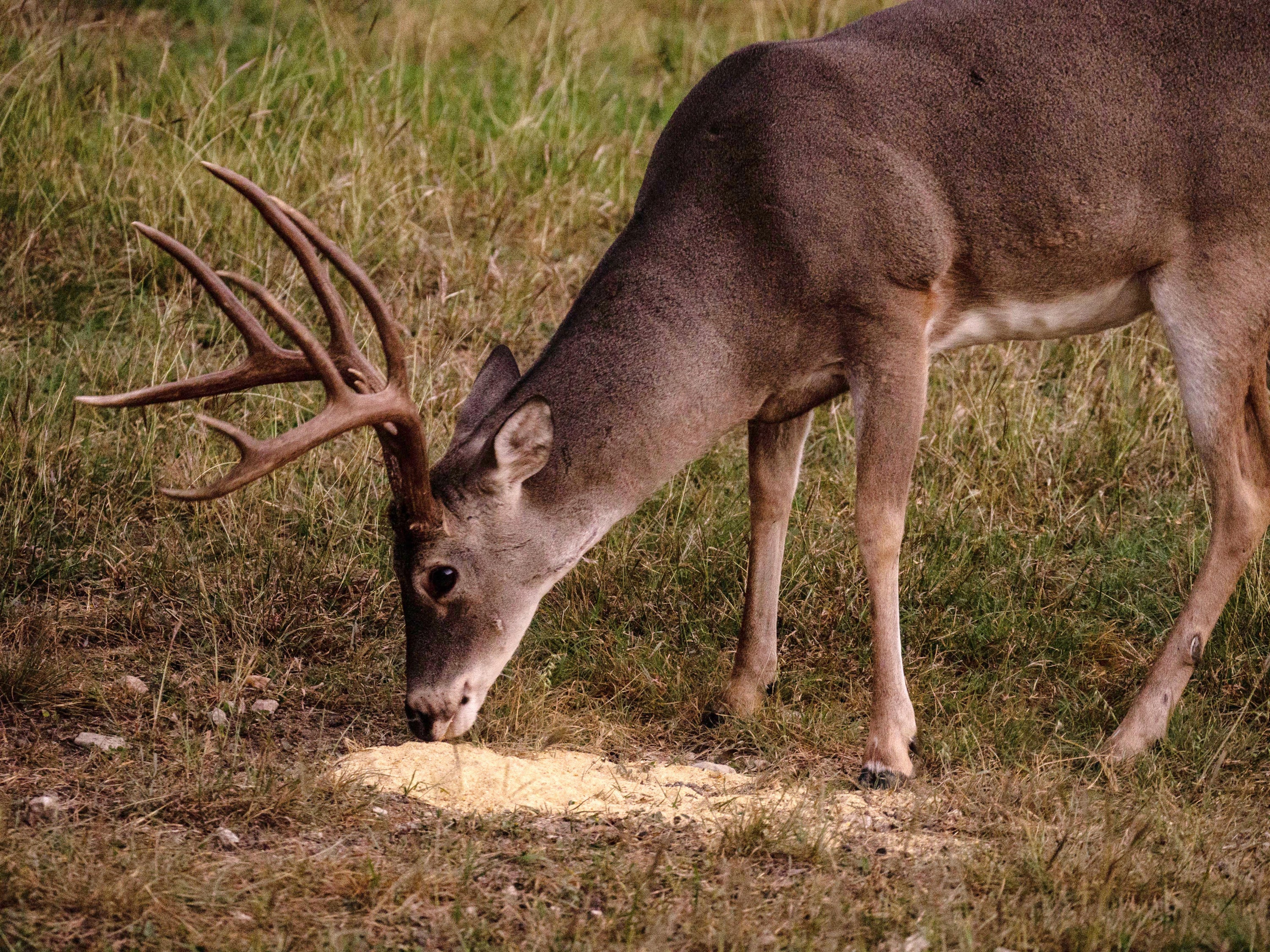

WHITETAIL NUTRITION
Deer fall into a category of grazer that is known as the concentrate selector meaning they seek plants or plant parts that are rich in nutrient availability and highly digestible. The ability to digest cellulose is not as advanced as other ruminant animals therefore the need for feeds high in digestible energy, protein, fats and oils is essential to optimize genetic potential in deer populations. In addition, as most hunters can attest, deer are picky eaters. Therefore, providing high quality feedstuffs that are attractive to deer are crucial to the success of managing deer populations.
One major thing to consider is that during a time of nutrient deficiency all non-essential biological activities (antler growth, reproduction, weight gain…) slow or cease in order to preserve the life of the animal. Nutrients needed for non-essential functions are redirected in order to maintain the health or life of the deer. Therefore, smart management of feed, supplements, and attractants for your deer herd can lead to greater herd health, greater inches on the wall, more meat in the freezer, and overall increased rates of success in the field. Listed below is an explanation of the major nutrient components of feed stuffs, a broad overview of what they are, how to determine quality feedstuffs, and the importance of quality feedstuffs.
Importance of the right type of feed
Energy
Starch although high in energy, very digestible, and readily available in corn and cereal grains can create digestive problems (acidosis) in deer. This is not to say that using “yellow acorns” in the management of a deer herd cannot be done or that they do not have their place when used correctly, it just means that it may not be the optimal way to improve heard health, and increase inches of bone that we are all so attracted to.
Acidosis in deer can lead to digestive upset that can result in weight loss, reduction of ruminal nutrient absorption and in severe cases death. In layman’s terms, acidosis in deer can lead to less meat in the freezer, less fawns to replenish the herd, and less bragging rights. Deer are accustomed to eating feeds low in starch and have a rumen environment that is not adapted to starch. The microbial population in the rumen of deer is comprised of species of bacteria that are fiber digesting bacteria and equipped to digest the feed stuffs that deer would consume in the wild (ie… grasses, acorns, young vegetative tree parts, growing crops, clover, alfalfa etc…). Therefore, using digestible feeds high in energy, low in starch, and palatable are crucial to increasing herd health and maximizing the potential for bone growth.
The most concentrated form of energy comes from vegetable oils/fats. When looking at energy contents fat has 2.25 more energy per pound than a pound of starch/sugar. However, overconsumption of fat can reduce the ability of the digestive system to digest fiber. Over feeding fat can inhibit the ability of microbes in the rumen to digest fiber into a usable energy source for the animal leading to an overall reduction in digestibility of feed. Therefore, it is critically important to formulate supplements and attractants so that fat is not over consumed by deer and becomes a limiting factor in digestion.
When considering quality sources of energy one must not look at the energy content alone but must consider digestibility of the energy source. This is typically measured as total digestible nutrients (TDN). As an example, energy is typically measured in calories and a calorie is defined as the amount of X needed to increase one gram of water one degree Celsius. Sounds easy, but if this were the case then wood/a tree stump/log/whatever you prefer to call it would have a lot of calories. This is where digestibility comes into play. It may not take much wood to increase 1 gram of water 1 degree Celsius, but people, beavers, deer, insert animal here cannot eat enough wood to sustain life due to the fact that the wood is mostly composed of indigestible fibers leading to a near zero TDN that is useless unless you are a termite.
Protein
Protein is a critical requirement for maximizing the potential of your deer herd. Not only is it important for muscle health and weight gain in deer, protein is critical for antler growth. In general deer need to consume a diet that is 16% protein; however, at certain times of the year the requirement may be higher or lower based on the cycle of production (recovery, reproduction, growth). For example, hardened antlers have a protein composition of approximately 45%. This makes protein a critical component for antler growth during the spring and summer when antlers are developing. A deficiency in protein during times of antler development will lead to a reduction in inches.
All protein is not created equal. For deer, type of protein is very important and feedstuffs used for protein supplementation need to be evaluated based on the amount of degradable protein (DP) and undegradable protein (UP). Degradable protein is protein that is produced by the animal from digestion of the bacteria in the rumen and typically is not of a concern when discussing protein requirements for ruminant animals as long as energy is not limiting. Undegradable protein is true protein provided to the animal from feed/supplement that passes through the rumen to the small intestine unaltered. Crude protein is a combination of both DP and UP and is a common measure shown on feed labels. Crude protein is measured by the nitrogen content of the feedstuff and does not describe if the protein is DP or UP therefore it is important to be informed of the protein composition (DP or UP). In conclusion the type of protein needs to be considered when making decisions on how to manage food plots, feeds, and attractants to supplement deer herds. Both DP and UP requirements of deer herds need to be met to maximize genetic potential.
Mineral
In their habitat feed stuffs consumed by deer mostly meet the needs of the animal but some gaps need to be filled. Perhaps the two most important minerals to consider are Calcium (Ca) and Phosphorus (P). These two minerals are critically important for bone health not just in antlers but in skeletal structure as well. During time of mineral deficiency deer will pull Ca and P from their bones in order to meet the needs of the rest of the body. When considering impacts on antler growth the most important thing to consider is that if the skeletal system is not replenished than antler development and growth will be delayed leading to less inches. Mineral composition of antlers is approximately 20% Ca and 10% P. Interestingly looking at the ratio of Ca and P in antlers will also tell you the proper ratio for deer in their diet which needs to be at 2 parts calcium to 1-part P.
Other minerals are important as well but are not needed at the same quantity as CA and P, they include zinc, magnesium, copper, and the list goes on. In an ideal situation, trace mineral, which by its name suggest that they should be fed in very small quantity or trace amounts, are essential to reproductive, immune and growth functions. Considerations to make when looking at trace minerals is the bio-availability or if the animal can absorb them. If the animal cannot absorb these ingredients than they just pass out of the animal and the money for supplementation in order to increase herd health or performance of deer has just been wasted.
In foods deer consume, mineral content is low, especially Ca, making it a primary concern when considering mineral supplement. Without the addition of Ca as an ingredient, most products on the market today used as deer supplements/attractants are devoid of Ca. Phosphorus can be more prevalent in forage but would mostly be seen in food plots where legumes (Alfalfa, Clover, etc…) are heavily favored. Phosphorus in food plots help with meeting the needs but in most cases supplemental P is still needed to meet the deficiency depending on the time of year.
Seasonality of needs
Looking at a year in the life of deer, one can come up with the best management strategy for success. Simply put, there are times of the year to be supplementing mineral, energy, protein, or a combination of nutrients in order to increase inches, reproductive functions, and weight. The simplest of road maps would suggest the plan look something like this:
Winter
Bucks are just coming out of rut and really run down, weight loss has occurred due to interest in “other things” and the body is depleted of protein, energy and mineral reserves. Winter is the ideal time to start with supplementation in order to increase the health and racks for next year. The sooner the body is replenished; the sooner the body will focus on production of non-life sustaining functions such as antler growth. In other word if you want to see bigger racks start rebuilding the bucks body after breeding season. This would include a good source of digestible energy, a good source of protein (DP and UP), and replenishing mineral stores in the body. One must really consider that available feeds are dormant and at its lowest nutrient quality of the year, meaning high quality feedstuffs are at a premium. Now one might say why am I worried about feeding or attracting my deer when hunting season is over and I am not sitting in the stand anymore? Remember that bucks have just come through their worst nutritional time of the year and are trying to replenish their bodies during the time of the year with the worst available nutrient supply. In addition, the faster skeletal structure, muscle, and fat stores are replenished the sooner healthy antler growth will begin, leading to increased inches.
As far as does are concerned, keeping them healthy and nutritionally balanced is important to sustain the new baby that has just been conceived and replenish the herd population for years to come.
Spring
Congratulations, your deer have made it through the hardest time of year. Things are starting to green up and life looks great. Interestingly during Spring there are still gaps in the diet of your deer herd that could be stalling production. Lush grass is everywhere and energy is more than likely not limiting but protein can still be deficient. Grass is very high in DP and very limited in UP which means that in order to meet the protein deficiency one must consider supplement with a feed source that is high in UP. Deer are gearing up for prime antler growth season and you do not want to short a buck’s protein before peak antler growth. Remember that hardened antlers have a protein composition of approximately 45%, meaning that shorting protein now would lead to less inches later.
Mineral supplementation is becoming even more important through the spring and summer months. Not just because feedstuffs available are practically devoid of Ca, but also as forages grow mineral content dilutes as the mass of the plant increases meaning that for every bite of grass consumed deer are taking in less mineral than they would during the Fall and Winter. Mineral needs to be available that would provide total dietary Ca and P of approximately 0.6% and 0.3%, respectively. In addition, Ca and P need to be at a ratio of at least 2:1.
Summer
Early Summer is the most critical time for protein and mineral supplementation for both bucks and does as far as antler growth and fawn production. Bucks are at the time of year where they have the greatest protein requirement because antler growth is in full swing and does are at peak requirement due to milking fawns and peak lactation which is the single largest nutrient draw on the females in the herd. In addition, during the early parts of the summer while grass is still green and growing, mineral supplementation is a must because of the relatively low mineral composition of grass and the dilution effect of stage of growth. However; as vegetation begins to go dormant and plants prepare for fall and winter the concentration of mineral in plant material increases and activity at mineral sites will begin to slow or even stop. Why? Deer are getting most or all of the mineral they need from what their habitat provides. This date is region specific as to when mineral consumption will slow or stop but should be expected to occur somewhere between August and September on average. In later summer as vegetation quality continues to decrease it is important to shift the focus of supplementation to energy as bucks and does are preparing for the rut.
Fall
Time for all of the hard work to pay off. During the fall the most important thing for deer is energy. Protein may be in short supply as well but given the time of year with rut and approaching winter, feedstuffs high in digestible energy are a must and if the energy source happens to be high in protein that is even better. During the breeding season bucks will often reduce intake mostly because they are interested in other “things” meaning that when they do stop and eat every bite needs to count. Does are preparing for winter and trying to store as much energy as they can by fattening up for the winter ahead when natural resources are either limited, low in digestibility, or both. Mineral consumption from mineral sites is non-existent as the biggest mineral draw for the season has occurred with horns grown/hardened and lactation for does over or nearing an end.
Seasonal planning road map
Winter - best combination of everything, you need to throw the kitchen sink at them. Planning and beginning management for next year’s season. Protein is a must, energy is in short supply, and mineral needs to be placed
Spring - Mineral is needed as dilution in natural feedstuffs is occurring due to growing season for plants. Still in the mode of replenishing protein and fat stores from winter and setting bodies up for the production season ahead. The sooner the body is replenished non-essential functions (antler growth, weight gain, reproductive) start or are maximized.
Summer - Early summer is critical for antler growth. Keeping mineral sites fresh, energy, and protein sources intact will start antler growth as early as biologically possible leading to increased inches. Late summer mineral intake will start to tail off as mineral concentrations in plant material increase due to dormant non-growing season. During late summer energy and protein need to be available to the animal with decreasing quality of dormant season plants.
Fall – Energy is critical as deer are preparing for winter. Does are recovering from lactation. Bucks become less interested in eating so make every bite count.
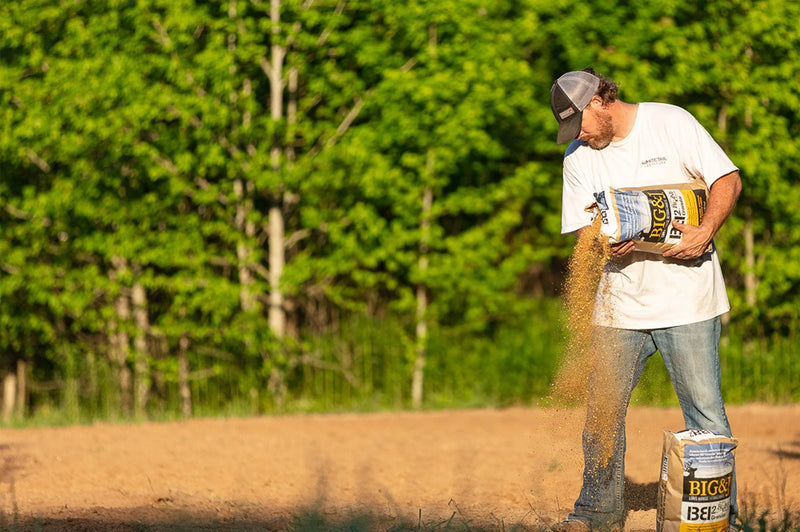
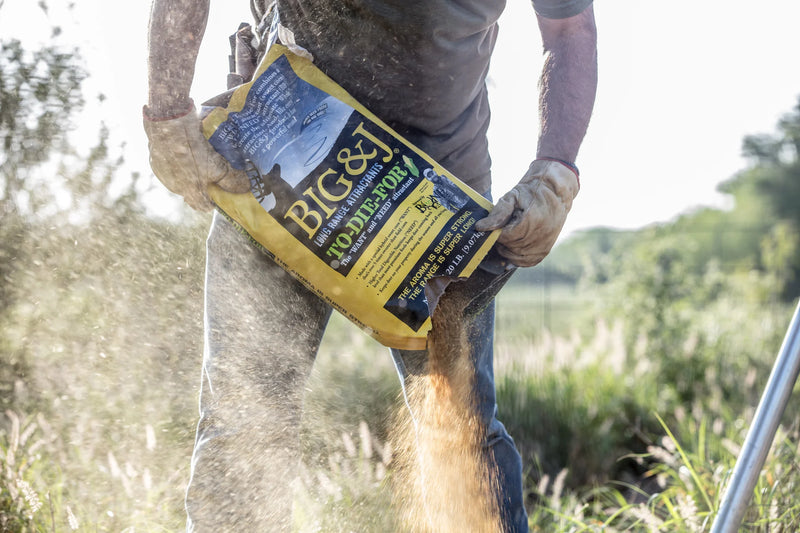
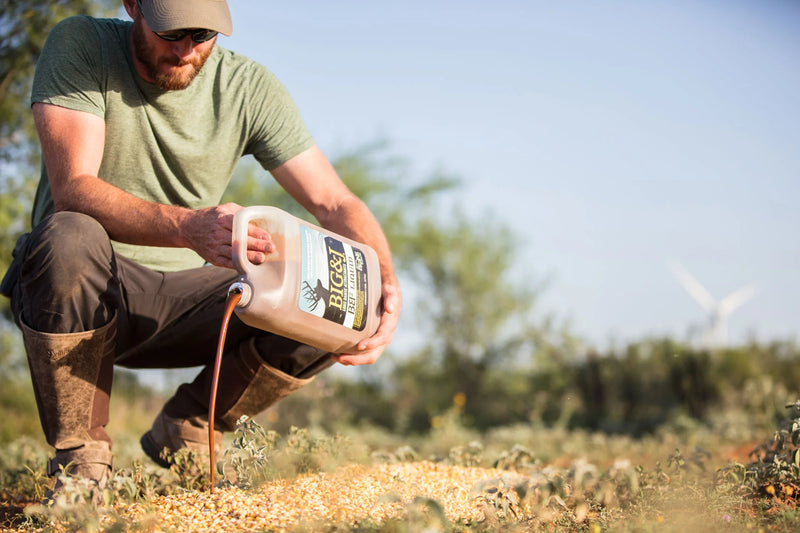
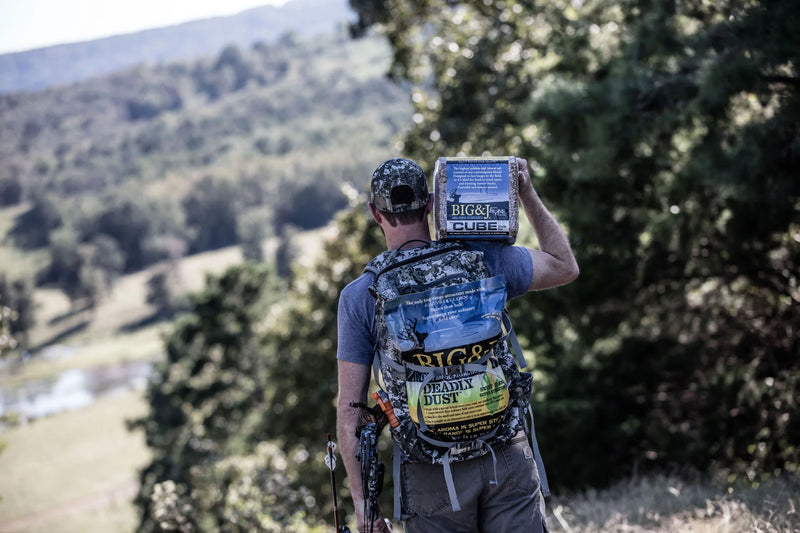
Where do Big and J products fit?
BB2 granular and Cube
Aside from the value as an attractant BB2 is over 90% digestible which is greater than corn. In addition, the energy comes primarily from digestible fiber and fat instead of starch and fermentable carbohydrate. This leads to a near zero chance of acidosis or digestive upset. The protein content of BB2 is guaranteed to be 18% as a minimum and is comprised of approximately 70% UP and 30%DP. Undegradable protein is more than likely a limiting factor when considering feedstuff availability vs requirements of deer. Remember not all protein is created equal and deer have adequate degradable protein supply from what they are grazing. Mineral content is not enough to meet the needs from a Ca standpoint but does include approximately 1% calcium and would meet all of the P needs, essential components for healthy antler growth. Given the energy content and the protein content, BB2 is the total package in attractant form; however; additional mineral supplementation is needed to maximize genetic potentials of production. When to feed: year round
Pour it on
On the surface BB2 Enhanced is the same as BB2, but that is where the similarities end. This product is perhaps the biggest game changer when talking about science in the bag and complete nutrition on a cellular level. On the surface the nutrient profile when looking at protein and fat may be similar to regular BB2 but the devil is in the details. Enhanced with the first and second limiting amino acids (building blocks of protein) in protected form. Protected amino acids are scientifically proven to make it through to the absorption sites for maximum biological potential. In addition, Enhanced is fortified with organic sources of Zinc, Copper, Magnesium, and Manganese which have greater bioavailability than standard sources. When to feed: year round.
Deadly Dust
Sweet corn based to throw a little variation into the feed pile. You would not want to eat the same thing every day and neither do deer. When the feed pile gets a little stale sweeten it up with deadly dust. Changes palatability profile to keep deer interested. Consist of 10% protein that is approximately 60:40 UP to DP. Digestible energy around 90%. Added Ca to nearly meet the Ca needs of deer and at a ratio of 10:1 compared to P. When to feed: year round
To-Die-For
The great attracting power of BB2 with the flavor profile of sweet corn. Offers another option in the buffet to keep feed sites from getting boring. To-Die-for provides the nutritional supplementation they need in a taste they will love. Guaranteed to be 20% protein and 7.5% fat, offering a great combination of digestible protein and energy in one product. To-die-for has a calcium and phosphorus content that will nearly meet a deer’s requirement, maximizing herd health and growth potential. In short, To-die-for has a flavor profile that deer cannot get enough of and it promotes growth of traits that drive hunter wild by filling nutritional gaps. When to feed: year round.
BB2 Liquid
Super charge the feed site with the attractant power of BB2 liquid. Pour it on the ground or blend in with other feeds to give the area the attracting aroma and taste that Big and J is known for. Unlike other liquid attractants that are flavored sugar water, BB2 liquid offers some nutritional value with a protein content of 8% and fat content of 2%. In addition, BB2 liquid provides salt that deer love and calcium and phosphorus they need to promote bone growth. When to feed: year round.
Liquid Luck
Great addition to any arsenal of attractants. Can be fed straight by pouring on the ground or stump that you would like to have some help grinding down. In addition, liquid luck can be added to other ingredients such as corn to increase the palatability, protein profile and bring salt/sodium content to an optimal level. Even though the protein level is only 8% the protein that is provided is mostly UP. Also, contains Ca and P to help balance the mineral needs in your deer herd. To top it off, liquid luck is packaged in a convenient to carry bag so getting it to that secret spot is easy. When to feed: year round.
Legit
Great source of Ca and P needed for bone/antler growth. Would meet the deficiency in the natural habitat. Includes trace minerals that are essential to reproductive function and healthy bone growth/antler growth. Apple flavored for attracting power. When to feed: Late Winter through early Summer.
Headrush
Headrush is a product that will not only aid in adding inches of bone, but the aroma and flavor will literally mess with their mind. Headrush is a salt-based formula with added Calcium and bioavailable trace mineral sources of Zinc, Manganese, Copper and Cobalt. We all know that deer love salt even when it is not fortified with other ingredients. Big and J has taken salt based supplements to the next level by adding an aroma that deer cannot resist,Calcium (a major component in bone and antler growth), and bioavailable trace elements that aid in cellular function and overall herd health. When to feed: Year round.
Melt Down
Great source of Sodium which would be next part of the puzzle once Ca and P are met. Sodium is needed for cellular function including amino acid (building blocks of protein) transport. In addition, deer have an appetite for Sodium meaning they will consume it even if the body does not need it. When to feed: Late Winter through early Summer.
Deer Dig It
Comes in both powder form and a premixed liquid. Deer dig it is a great source of Sodium, which would be next part of the puzzle once Ca and P are met. Sodium is needed for cellular function including amino acid (building blocks of protein) transport. In addition, deer have an appetite for Sodium meaning they will consume it even if the body does not need it. Deer dig it also has the addition of bioavailable trace minerals Zinc, Manganese, and Copper, which have greater absorption rates when compared to traditional sulfate mineral sources. In other words, it gets where the body needs it instead of being excreted by the animal and wasted. When to feed: Late Winter through early Summer.
